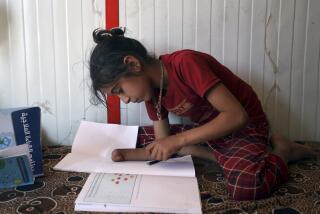Another chlorine gas bomb attack in Iraq
- Share via
BAGHDAD — For the second time in two days, suspected Sunni Arab insurgents Wednesday targeted civilians with a crude chemical weapon: a bomb attached to chlorine gas canisters that killed two people, sickened 25 and injured eight others.
The attack was the third in a month involving a combination of explosive devices and chlorine. Though all three attacks were apparently botched, they hint at an ominous new tactic being cultivated by insurgents to subvert a U.S.-Iraqi security crackdown in Baghdad.
Violence around the country left at least 40 other Iraqis dead. An American soldier was reported killed in a small-arms fire attack a day earlier in Baghdad, and a U.S. Black Hawk helicopter was forced to make a hard landing Wednesday north of the capital amid reports of ground fire, the military said.
The chlorine gas attack took place on the road leading to Baghdad’s airport. A car filled with chlorine gas cylinders exploded near a fuel station in a religiously mixed neighborhood.
The tactic was used the day before in Taji, north of Baghdad, when insurgents detonated a truck holding two chlorine gas tanks. Six people were killed, and scores more suffered nausea, vomiting and irritated eyes.
A suicide bomber also plowed a dump truck filled with explosives and a chlorine tank into the base of a rapid-reaction force near Ramadi on Jan. 28, killing 16 people. “There are no indications of any casualties caused by the release of chlorine gas,” the U.S. military said at the time.
The use of chlorine gas weapons in warfare dates back at least to World War I, when Germans first used them in April 1915 to dislodge French soldiers from trenches. The weapons caused far more injuries than deaths.
Chlorine can burn the eyes, nose and throat and cause dizziness, nausea and vomiting. In higher doses -- a few breaths at a concentration of one part per thousand -- it can damage enough lung tissue to be fatal.
Chemists said that exploding high-pressure canisters are at best a crude way to disperse the green gas. Some would burn off, and the rest of the gas, which is heavier than air, would be unlikely to spread much beyond the blast zone.
Stephen Bradforth, a chemistry professor at USC, suggested that the most serious damage could be psychological.
An explosion “would launch a cloud of gas that is colored and highly corrosive and would lead to panic and more injuries,” he said. “It’s the chemical equivalent of a nail bomb.”
The U.S. Black Hawk helicopter went down near Taji. “Indications are now -- again, it’s preliminary, but the indications are now that it was brought down by small-arms fire and ... rocket-propelled grenades,” Army Maj. Gen. William B. Caldwell IV, the chief U.S. military spokesman in Iraq, said on CNN.
The military said another helicopter landed and rescued the nine people aboard the Black Hawk. At least eight helicopters have crashed, been shot down or forced to make unplanned landings in just more than a month.
In Web postings, insurgents have announced plans to target U.S. aircraft in another new front to undermine the security effort. Helicopters have been increasingly used by American troops as a means of avoiding deadly roadside bomb explosions, but officials have said insurgents are finding new ways to target them.
The bodies of at least 20 unidentified men were found dumped throughout Baghdad, police said Wednesday. All were killed by gunfire. A late-afternoon car bomb explosion at a market in the Sadr City district of the capital killed three Iraqis and injured 30.
Several roadside bomb attacks in southern Baghdad killed at least three Iraqis and injured two.
Violence also erupted in the country’s predominantly Shiite south, where U.S. and British-led forces have begun handing control over to Iraqi authorities.
In Najaf, home to influential Shiite Muslim seminaries and the most revered Shiite shrine in Iraq, a suicide bomber driving a Chevrolet Caprice detonated his explosives at a police checkpoint as officers were inspecting his vehicle. The blast spread wreckage, body parts and blood over 30 yards. At least 11 people were killed, including four policemen, and 37 were injured in the bombing, a Najaf hospital official said.
“My car was behind the car that exploded,” said Ridha Mayoof, a 40-year-old taxi driver recovering at the hospital from shrapnel wounds. “I saw a huge flame coming out of the car in front of me. Bodies and parts of the car were flying.”
In the southern city of Samawah, gunmen ambushed and killed Mohammed Hanoon, the deputy chairman of the provincial council, as he was leaving a mosque after morning prayers. Hanoon was the second member of the council assassinated in two months. A suspected former member of the late former President Saddam Hussein’s intelligence services was shot dead in Kut, also in the south.
Authorities found an unidentified body in a drainage canal near Iskandariya, about 50 miles south of Baghdad.
*
Special correspondent Saad Fakhrildeen in Najaf, special correspondents in Baghdad, Baqubah, Hillah and Taji, and Times staff writer Alan Zarembo in Los Angeles contributed to this report.
More to Read
Sign up for Essential California
The most important California stories and recommendations in your inbox every morning.
You may occasionally receive promotional content from the Los Angeles Times.













